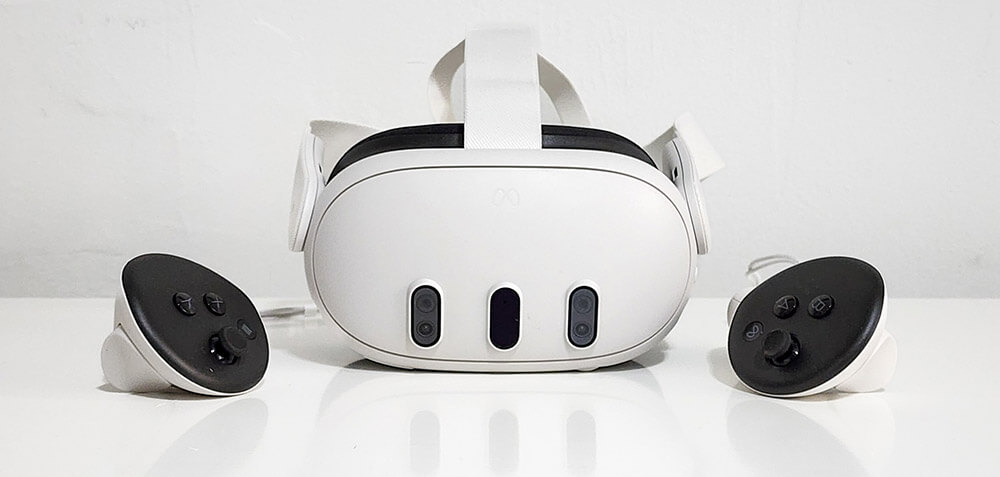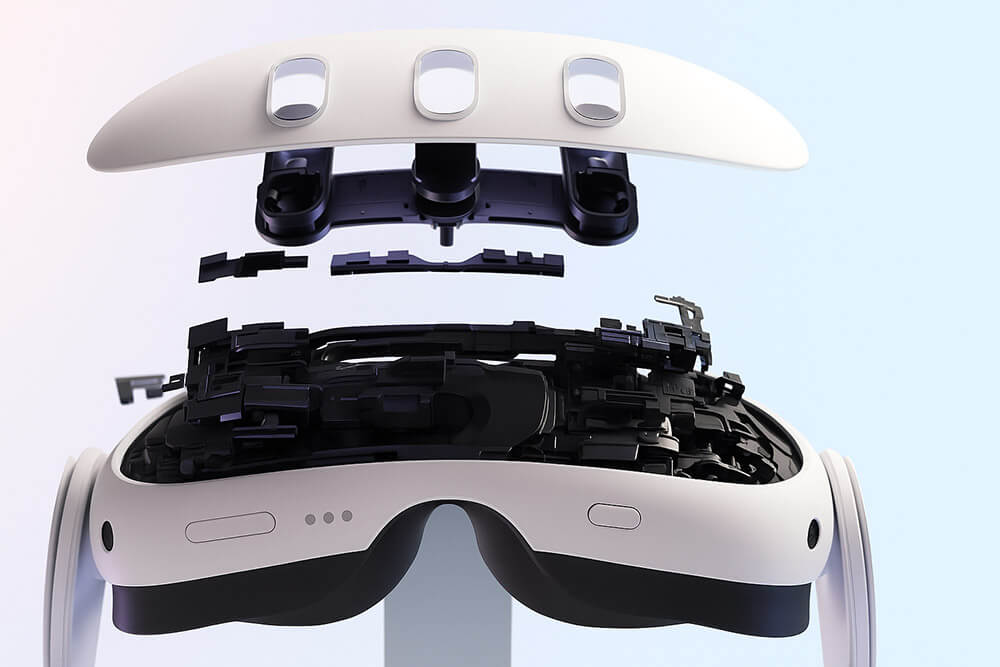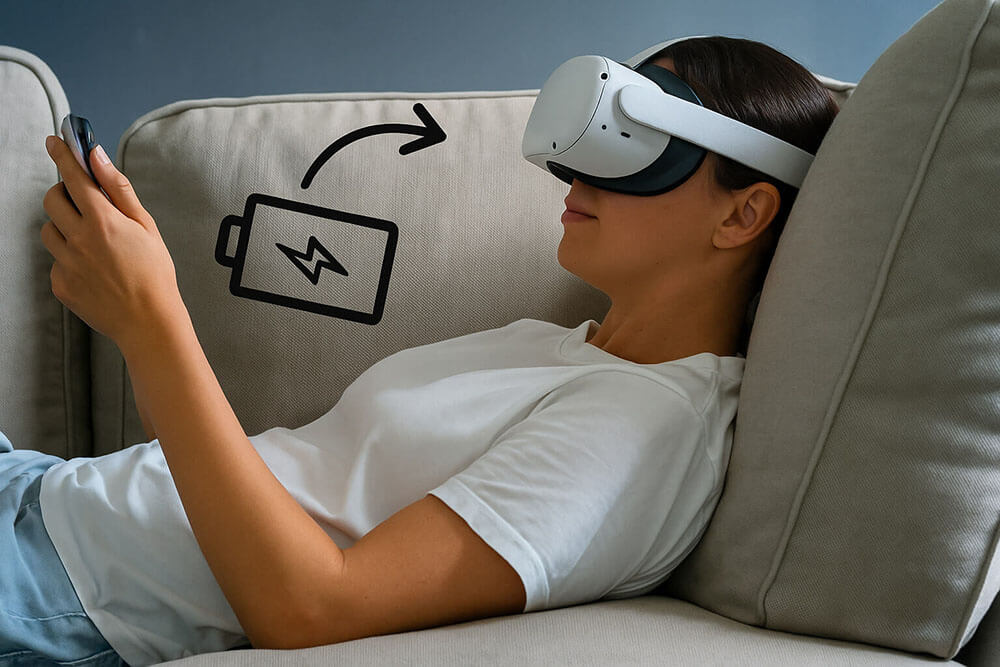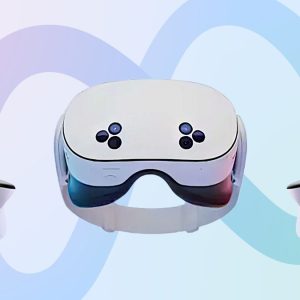The Meta Quest 3 is here — slimmer, sharper, and more powerful than ever. As Meta’s latest entry in the standalone VR market, it promises to redefine both virtual reality and mixed reality experiences. But with increasing competition, including the ultra-premium Apple Vision Pro and the ever-popular Quest 2, many are asking the key question: is the Meta Quest 3 really worth it in 2025?
In this ultra-detailed review, we’ll explore every aspect of the Meta Quest 3 — from design, display, performance, battery life, and comfort, to its game library and mixed reality capabilities. We’ll also compare it head-to-head with its predecessor, the Quest 2, and with Apple’s Vision Pro to help you make the smartest buying decision.
Whether you’re a seasoned VR enthusiast or considering your first headset, this comprehensive guide will tell you everything you need to know about the Meta Quest 3 — and whether it deserves a spot on your wishlist this year.
1. What is Meta Quest 3?

The Meta Quest 3 is the latest generation standalone VR headset from Meta (formerly Oculus), officially released on October 10, 2023. It represents a major leap forward in virtual reality and mixed reality (MR), targeting a wide range of users — from gamers and fitness enthusiasts to creators and casual explorers.
Unlike PC-tethered headsets like the Valve Index, or premium devices like the Apple Vision Pro, the Quest 3 is a self-contained, wireless device. It requires no external sensors or computer and operates entirely on its own, delivering a complete VR/MR experience right out of the box.
Key specs at a glance:
Chipset: Qualcomm Snapdragon XR2 Gen 2
RAM: 8 GB
Display: Dual 2064×2208 LCD panels with 90–120 Hz refresh rate
Lenses: Pancake optics for thinner design and wider clarity
Passthrough: Full-color mixed reality with dual 4 MP RGB + depth sensors
Weight: ~515 g
Audio: Built-in spatial stereo speakers
Price: Starts at $499 (128 GB), $649 (512 GB)
With this new release, Meta aims to bridge the gap between pure VR and mixed reality, making the Quest 3 not just an upgrade from the Quest 2 but a gateway to the future of immersive computing.
👉 If you’re already interested, you can check the latest price and availability for the Meta Quest 3 on Amazon here: Meta Quest 3 .
2. Design & Ergonomics
The Meta Quest 3 represents a significant leap in headset design compared to its predecessors. Meta has clearly listened to user feedback on comfort and form factor:
Slimmer profile: Thanks to the adoption of pancake lenses, the Quest 3 is 40% thinner than the bulky Quest 2. This sleeker silhouette not only looks more modern but reduces front-heavy weight, improving comfort.
Weight distribution: Weighing approximately 515 grams, the Quest 3 feels lighter on the face. The improved Y-strap design and cushioned facial interface make long VR sessions much more tolerable.
IPD adjustment: Unlike Quest 2’s three-step physical lens positions, the Quest 3 features a precise IPD adjustment wheel allowing for fine tuning between 53 mm and 75 mm — critical for sharp visuals and reduced eye strain.
Built-in audio: The spatial audio speakers are now 40% louder with richer bass, delivering a more immersive soundscape. You can enjoy games and MR experiences without needing external headphones.
Verdict: The Quest 3 is not only thinner and lighter but also better balanced and more adjustable, offering a far superior ergonomic experience than the Quest 2.

3. Display & Visual Clarity
The display upgrades in the Meta Quest 3 are among its standout features:
Resolution: Each eye enjoys a resolution of 2064 x 2208 pixels, up from Quest 2’s 1832 x 1920 pixels. This delivers a noticeable 12% pixel density increase, making text, UI elements, and distant objects crisper.
Pancake lenses: These advanced lenses offer edge-to-edge clarity, reducing the “sweet spot” limitations of the Quest 2. Chromatic aberration and blurring at the edges are dramatically reduced.
Refresh rate: The display supports 90 Hz by default, with experimental support for 120 Hz — perfect for games demanding smooth motion.
Passthrough quality: One of the biggest visual leaps is the full-color mixed reality passthrough. Thanks to dual 4 MP RGB cameras and depth sensing, the passthrough mode looks sharp enough to interact with real-world objects, far beyond the Quest 2’s grainy black-and-white feed.
Verdict: The Quest 3’s display quality rivals premium VR headsets and offers a night-and-day improvement over the Quest 2, especially in clarity and mixed reality.
4. Performance & Hardware

Under the hood, the Quest 3 is a powerhouse:
Chipset: The headset is powered by the Qualcomm Snapdragon XR2 Gen 2, delivering roughly 2x the graphical power of the XR2 Gen 1 used in the Quest 2. Expect smoother gameplay and higher fidelity graphics.
RAM: 8 GB of RAM ensures faster app switching and more stable multitasking compared to the Quest 2’s 6 GB.
Mixed reality engine: The depth sensor enables enhanced MR blending — objects in your room can be overlaid with digital content in natural ways.
Body tracking: Meta has begun rolling out body tracking APIs and leg inference, allowing developers to create more immersive MR/VR apps where your avatar has a full-body presence.
Verdict: In terms of raw power, the Quest 3 is currently unmatched among standalone VR headsets under $1,000.
5. Controllers & Tracking
The Quest 3 introduces refined Touch Plus controllers:
Design: These new controllers drop the signature tracking rings in favor of inside-out tracking, using headset cameras for positioning. This makes them slimmer and lighter.
Haptics: Improved haptics provide better tactile feedback, especially in VR games like Beat Saber or pistol shooters.
Hand tracking: The headset features vastly improved hand tracking with lower latency and more stable gesture recognition. Many MR apps can seamlessly switch between controllers and hands.
Power: The Touch Plus controllers are powered by AA batteries rather than rechargeable units, which some users may see as a step back in convenience.
Verdict: The new controllers work well and the addition of advanced hand tracking brings more flexibility, although built-in rechargeable options would have been welcome.
6. Battery Life & Portability

Battery life is an area where the Quest 3 remains consistent with its predecessor:
Battery duration: Expect 2–3 hours of continuous gameplay depending on the intensity of the title and whether MR passthrough is used heavily.
Charging: The headset charges via USB-C and supports fast charging if using a high-wattage charger.
Portability: While still a bit bulky for casual travel, the slimmer design makes the Quest 3 easier to fit into backpacks. Dedicated cases are available for protection.
Offline use: Meta still limits some offline functionality — certain apps and services require an online connection.
Verdict: Battery life is on par with Quest 2 and acceptable for typical VR sessions, though not long enough for extended travel use without charging options.
7. Software & Game Library

Meta is doubling down on content:
Backward compatibility: The Quest 3 retains full backward compatibility with the entire Quest 2 library of over 500 VR games and experiences.
AAA titles: Meta is investing heavily in new content. Exclusive titles like Assassin’s Creed Nexus VR, Asgard’s Wrath 2, and partnerships with major publishers elevate the game library.
Mixed reality apps: A growing number of MR apps take advantage of the Quest 3’s color passthrough. Use cases include virtual pinball, 3D art tools, and productivity spaces.
Cloud gaming: The Quest 3 supports Xbox Cloud Gaming, turning the headset into a portable screen for Xbox games — a compelling feature for casual gamers.
Verdict: The software library is one of Quest 3’s greatest strengths, with unmatched value compared to more expensive MR headsets.
8. Price & Value Proposition
One of the biggest strengths of the Meta Quest 3 is its outstanding value compared to the competition.
The headset starts at just $499 for the 128 GB version, and $649 for the larger 512 GB model. This places it comfortably in the mid-range VR market, making it accessible to a wide audience.
In contrast, the Apple Vision Pro is positioned at a staggering $3,499, clearly targeting professional and luxury users.
With the Quest 3, you get a complete standalone headset — no PC, no external tracking, no extra hardware required. It’s ready to deliver immersive VR gaming, fitness apps, mixed reality experiences, and even media consumption right out of the box.
For anyone looking to enter VR or upgrade from an older headset, the Meta Quest 3 offers the best price-to-performance ratio in 2025.
👉 Ready to experience next-gen VR? See current deals and bundles for the Meta Quest 3 here .
This is an especially good opportunity if you’re looking to pair the headset with accessories such as the Elite Strap with Battery, a charging dock, or carrying case — often available in bundled discounts.
9. Quest 3 vs Quest 2: The Upgrade Case

Upgrading from the Quest 2? Here’s why it may be worth it:
Visual clarity: Significantly sharper visuals, larger sweet spot with pancake lenses.
Mixed reality: Full-color passthrough unlocks a new category of MR experiences.
Comfort: The Quest 3 is lighter, slimmer, and more comfortable for long use.
Performance: Faster chipset allows higher fidelity graphics and smoother performance.
However, if you’re a casual VR user and satisfied with your Quest 2 for light gaming or fitness apps, the upgrade may not be mandatory.
| Feature | Quest 2 | Quest 3 |
|---|---|---|
| Resolution | 1832×1920 | 2064×2208 (+~12%) |
| Optics | Standard LCD | Pancake lenses, larger sweet‑spot |
| Performance | XR2 Gen 1 | XR2 Gen 2 (x2 gfx) |
| Passthrough | B&W grayscale | Full-color, depth‑aware |
| Comfort & Weight | Heavier, bulkier | 40% slimmer, Y‑strap, lighter |
| Controllers | Ringed Touch | Slim Touch Plus, haptics, AA-powered |
Verdict: For Quest 2 owners, the visual and comfort improvements combined with mixed‑reality juice make for a compelling upgrade. For new buyers, Quest 3 is arguably the best standalone headset under $1,000.
10. Quest 3 vs Apple Vision Pro: Clash of Tiers
Meta Quest 3 Advantages:
Price: $499 vs $3,499.
Gaming-first ecosystem with rich VR library.
Lightweight, no tethering to a Mac required.
Widely available globally.
Apple Vision Pro Advantages:
Ultra-premium micro-OLED displays with near-retina resolution.
Eye tracking and sophisticated gesture input.
Industry-leading MR apps for productivity and creative work.
Tight integration with the Apple ecosystem (Mac mirroring, iOS apps).
Verdict: The Vision Pro is not really a competitor for gaming—it’s a productivity and MR workspace device. The Quest 3 dominates in gaming and budget-friendly MR, while the Vision Pro offers luxury experiences for a niche audience.
11. Limitations to Consider
Despite its strengths, the Quest 3 is not perfect:
Battery life: Heavy users may find 2–3 hours limiting for marathon sessions.
Mixed reality maturity: MR apps are still in their infancy, and many experiences feel like early tech demos.
Comfort variance: Some users report nose pressure or facial fatigue after long sessions.
Controllers: AA batteries and lack of camera tracking may not appeal to all users.
No eye tracking: Compared to Vision Pro, Quest 3 lacks eye tracking — a feature that could unlock more natural interaction in the future.
Verdict: These limitations are minor considering the price, but worth keeping in mind if you expect “perfect” MR or productivity.
Conclusion: Is the Meta Quest 3 Worth It?
Yes — the Meta Quest 3 is absolutely worth it for most users in 2025.
If you’re seeking a standalone VR headset with:
Sharper visuals and immersive mixed reality,
Improved comfort and ergonomics,
Access to one of the richest VR gaming libraries on the market,
Future-proof hardware ready for the next wave of mixed reality apps,
… then the Meta Quest 3 delivers phenomenal value.
Compared to the Quest 2, it’s a worthy upgrade for those who want a better visual experience and full-color MR. Compared to the Apple Vision Pro, it offers exceptional bang-for-buck for VR gaming and casual MR, at just a fraction of the cost.
👉 Interested? You can grab the Meta Quest 3 now and start exploring the future of VR and MR today







